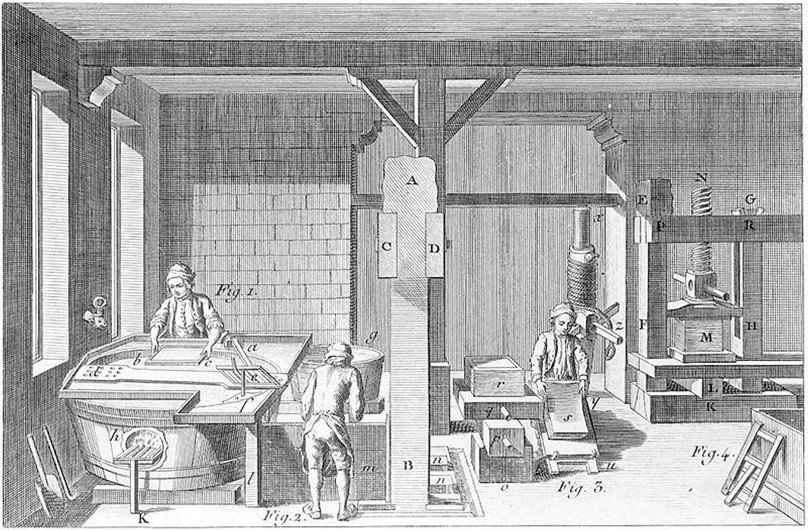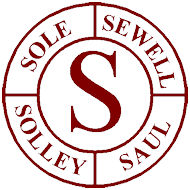By Maureen Storey
This article was published in the December 2024 edition of Soul Search, the Journal of The Sole Society
At the 1851 census 68 year-old Joseph Soul, a former papermaker, who was born in Overbury, Worcestershire, was lodging in the house of John and Jane Smith in Maidstone High Street. Joseph’s family has been traced back to his 3xgt grandparents George Soule and Jane Hatton, whose children were baptised in Winchcombe, GLS between 1675 and 1690. Over the years Joseph’s branch of the family had moved from Winchcombe to Sudeley, Abenhall and then Overbury, before Joseph settled in the Maidstone area in about 1805. All of these places have a strong tradition of papermaking and as we know that both Joseph’s brother William and his grandfather George Soul were also papermakers, this suggests that the family had been involved in the industry for several generations.
The papermaking industry changed radically during Joseph’s life. Before the early 1800s all paper in Europe was made by hand from cotton and linen rags, which were sourced either from cloth making factories or from household waste. The first step involved soaking the rags in water in a large container and then beating them to break the cotton and linen down into cellulose fibres. A wire mesh was then lowered into the container and this picked up a layer of fibres. On withdrawing the mesh from the container the fibre layer was spread evenly to the edge of the mesh, pressed to remove excess water and hung up to dry. The process seems simple but required skilled workmen to produce paper that was of both high quality and consistent thickness and colour. As the paper was produced in single sheets, it was a slow and expensive process.
By the early 1800s the industry was facing two problems: it was having trouble keeping up with demand and cotton and linen rags were in short supply. The first machine designed to mechanise papermaking was patented in 1799 in France by Nicholas-Louis Robert, but it wasn’t a success. However, his ideas were taken up in England by brothers Henry and Sealy Fourdrinier and they together with Brian Donkin built the first successful machine for the papermill at Frogmore, Hertfordshire, in 1803. Both the Fourdrinier machine and the similar one patented by John Dickinson in 1809, which used a different arrangement for the mesh on which the paper was deposited, produced paper as wet sheets that then needed to be hung up to dry. However, in 1821 T B Crompton patented a method of drying the paper using steam heated rollers before it was cut into sheets. Mechanisation not only greatly increased the rate of production but also allowed paper to be produced in larger sizes. The industry rapidly adopted mechanisation and by 1820 it is said that more paper was produced by machine than by hand.
This still, however, left the paper industry with its other problem, i.e. a limited supply of cotton and linen, the raw material of the paper pulp. Attempts to use other materials, such as straw, were unsuccessful because they gave poor quality results. Then, in 1843 Friedrich Gottlob Keller invented a wood-grinding machine that produced pulp suitable for making paper and this was followed in 1854 by the development of a chemical method of producing the wood pulp. Wood, being cheap and readily available, rapidly became the main raw ingredient of paper production.
The mechanisation of papermaking led to huge changes in the working life of those in the factories. It had always been a hard life but before mechanisation the skill required meant that it had been relatively well paid. However, the new machines reduced the skill needed and employers reduced their employees’ pay, leading to much unrest in the industry.

Joseph’s private life seems to have been as turbulent as his work life must have been. He arrived in the Maidstone area in about 1805 and the records we have show that he moved frequently between the papermaking villages in the vicinity: Hollingbourne, River, Shoreham, Wrotham and Maidstone itself are all mentioned. He had three different ‘wives’ and at least 13 children: four with Ann, six with Jane and three with Mary, but so far only one marriage has been found, that to Jane Blake in Shoreham in 1811. The marriage did not last and Jane eventually settled in Shoreditch, Middlesex, where she gave evidence at two settlement examinations, one when she applied for poor law relief and one when her daughter-in-law sought help. These contain slightly conflicting accounts of her life and are not always clear but throw some light on her relationship with Joseph and are transcribed below:
From the Settlement Papers for Jane Soul, Shoreditch, Middlesex, 1834
She was then cohabiting with Thomas Crosby and by him had five children, namely…
Soul was a papermaker, then working at Wrotham. She thinks he is still alive. She had several children with him. He is living with another woman. He was a papermaker and was when she last saw him about 12 years ago working for a Mr Thomas at Barstead near Sevenoaks in Kent. They have been living separate between 13 and 14 years. She has not seen him for 12 years. About three years ago she was informed by a tramp that he was gone to Italy
From the Settlement Papers for Margaret Jane Crosby, daughter-in-law of Jane Crosby, Shoreditch, Middlesex, 1852
Jane Cosby, aged 59, says ‘I was married to Joseph Soul, now about 70 to 80 years of age, in the year 1811 (24th Dec) at Shoreham church near Seven Oaks Kent. – and lived together for 12 years thereafter – had 6 children. He then went into the country. I have seen him since and I believe he is living in Maidstone (High St), Kent.
I was married to Thomas Crosby at a house in Doulons France about 30 years ago. I did not know that Soul was living when I was married to Crosby… When I came to England I found out that Soul was living at Maidstone. He receives relief from Maidstone so it must be his place of settlement.
Jane Soul, 25 Dorset Crescent, saith that on or about 1811 she was married at Shoreham in Kent to Joseph Soul (who she believes was then married to another woman). She had three children. The last time she saw him was between 11 and 12 years ago at Wrotham in Kent where he was then living. Examinent was then living in Dartford.
It’s difficult to know how much credence to give to Jane’s claim that Joseph was already married when he went through a marriage ceremony with her in 1811. It could be that she was just covering up the fact that if Joseph hadn’t married her bigamously, then her own marriage to Thomas Crosby was bigamous. All but one of Joseph’s children that survived infancy seems to have stayed with him rather than going with their mothers – they all married and brought up their families in the Maidstone area. The exception was Jane’s daughter Louisa Soul (b 1819) who married and lived near her mother in Shoreditch.
Joseph died in Coxheath Union Workhouse in 1856 aged 73.
